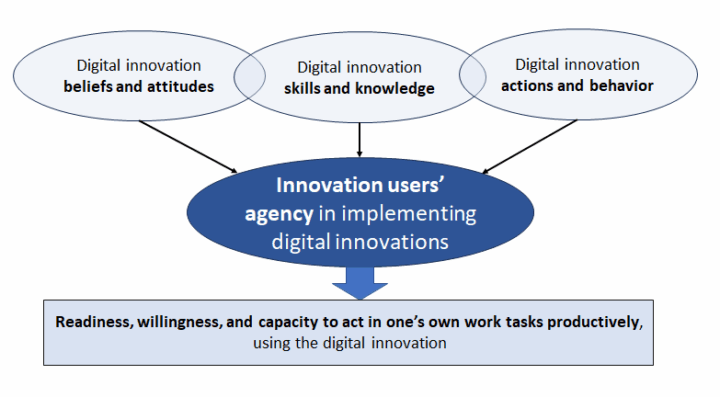Human involvement is central in the digitalization of life sciences manufacturing
Firms implement various digital innovations to pursue increased efficiency, accuracy, and quality in their manufacturing processes. LifeFactFuture project’s work package 2 concentrates on manufacturing excellence. University of Turku’s Industrial Engineering and Management researchers are investigating human agency in implementing digital innovations in life sciences manufacturing and organizations’ ways to support it.
Digital innovations in manufacturing
Digital innovations may mean any novel data-enabled technologies that firms take into use. In manufacturing contexts, this may mean, for example, automation or automated control of work processes, information systems and related tools, data analytics, remote monitoring and control, machine vision, embedding artificial intelligence into the digital systems, internet of things, and any combination of these. Digital innovations imply new working practices and routines for employees and managers.
Human agency in digital innovation implementation
Very often digitalization is considered merely as a technical and operative implementation effort. However, part of the successes and challenges concerning digitalization can be attributed to the people who are expected to use digital innovations in their work. Humans are active agents who may decide to use or not to use the novel technologies in their work. They may also encourage or discourage others from the use of novel technologies. Agency in digital innovation implementation means the individuals’ capacity to act in using the technology. Agency is formed by attitudes and beliefs, knowledge and skills, and actions and behaviors, all of which play out differently depending on the context and circumstances where the digital innovation is taken into use. Since people in manufacturing contexts work in a social setting, one individual’s attitudes, skills, and behaviors may influence those of the other people.
Four LifeFactFuture workshops
LifeFactFuture consortium members participated in three online workshops and one face-to-face workshop to discuss experiences of human agency in digital innovation implementation. The online workshops combined learnings from previous research and findings from a multiple-case study with consortium companies. Various digital innovations were covered, including automation, enterprise resource planning implementation and modernization, and artificial intelligence tools.
Different digital innovations imply different extents of work change
Digital innovations change people’s work in different ways, depending on what kind of technology is being introduced, how the organization handles the change, and how ready the employees are to adapt to the new ways of working. Some technologies bring small improvements that make work smoother and help people collaborate better. Others require more dramatic changes, such as new work roles, new working routines, and new responsibilities.
The extent of change experienced at work does not only depend on how advanced the technology is. It also depends on how the change is communicated, how much support is given to employees, and how well the new tools are accepted and taken into use in everyday work. If the implementation is well planned and supported, the transition can be smoother and more successful. Different digital innovations imply different changes because they interact with a complex web of human and organizational dynamics. Understanding and addressing these factors is essential for ensuring that technological progress translates into meaningful and sustainable improvements in the workplace.
Organizations include different agency profiles
Even within one single organization, with a specific digital innovation, it is evident that users face the digital innovations differently. Their attitudes, skills, and behaviors vary individual-by-individual, and even the individual combinations of attitudes, skills, and behaviors may vary depending on the context, the situation, and the specific digital innovation. Research sometimes treats negative attitudes in terms of resistance, but our research shows that people with negative attitudes may very well possess quite advanced technology skills and proactive behaviors regarding technology use. In a social setting, individuals with different agency profiles may help each other both in handling the digitally enhanced tasks and in learning to use the novel technologies.
Organizational support in implementing digital innovations
Firms need to acknowledge the diversity of innovation users’ needs, when implementing digital innovations. This will require identifying the different digital innovation agency profiles and developing support mechanisms for them. Digital innovation implementation cannot succeed, if there is just one single support mechanism which might make skewed assumptions about individuals’ attitudes, skills, and behaviors. Rather, firms need to develop a platform of alternative types of support, to fit to the variety of attitude, skill, and behavior profiles of innovation users.
The path ahead is not just about implementing more technology, it is about better integration of people and technology toward life sciences manufacturing excellence. Organizations that understand and support their employees in using new technologies will be more successful in handling digital changes and creating a workplace that works well and feels good for everyone. We now plan follow-up studies to track how employees’ digital innovation agency evolves over time, when digital innovations become more embedded in everyday work. Understanding the evolving digitalization change will help organizations cope with not just employees’ initial reactions to new technologies, but also long-term adaptation, learning, and cultural shifts.
Miia Martinsuo, Professor, miia.martinsuo(a)utu.fi
Maarit Päällysaho, Project Researcher, Doctoral Researcher, maarit.paallysaho(a)utu.fi
University of Turku, Industrial Engineering and Management

